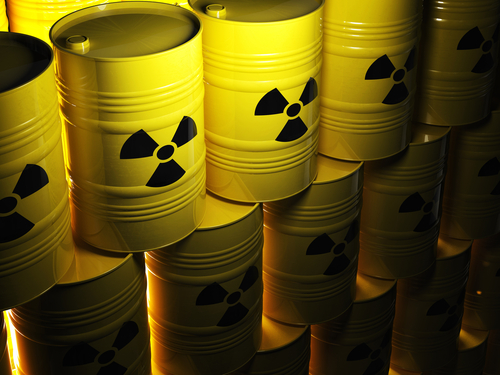Decontamination is a vital process for employees who handle hazardous wastes because it removes or neutralizes contaminants that have accumulated on personnel and equipment.
 |
Decontamination serves the following purposes:
- It protects workers from hazardous substances that may contaminate and eventually permeate the protective clothing, respiratory equipment, tools, vehicles, and other equipment used on-site.
- It protects all site personnel by minimizing the transfer of harmful materials into clean areas.
- It helps prevent mixing of incompatible chemicals, and protects the community by preventing uncontrolled transportation of contaminants from the site.
Permeation Factors
If contaminants that have permeated a material are not removed by decontamination, they may continue to permeate to either surface of the material where they can cause an unexpected exposure.
Five major factors affect the extent of permeation:
- Contact time. The longer a contaminant is in contact with an object, the greater the probability and extent of permeation. For this reason, minimizing contact time is one of the most important objectives of a decontamination program.
- Concentration. Molecules flow from areas of high concentration to areas of low concentration. As concentrations of wastes increase, the potential for permeation of personal protective clothing increases.
- Temperature. An increase in temperature generally increases the permeation rate of contaminants.
- Size of contaminant molecules and pore space. Permeation increases as the contaminant molecule becomes smaller, and as the pore space of the material to be permeated increases.
- Physical state of wastes. As a rule, gases, vapors, and low-viscosity liquids tend to permeate more readily than high-viscosity liquids or solids.
Meet your OSHA-required 8-, 24-, or 40-hour HAZWOPER training requirements with a DVD that contains 17 customizable PowerPoint presentations and a manual training kit. Get the details.
Decontamination Methods
Decontamination methods either:
- Physically remove contaminants;
- Inactivate contaminants by chemical detoxification or disinfection/ sterilization; or
- Remove contaminants by a combination of both physical and chemical means.
Many factors, such as cost, availability, and ease of implementation, influence the selection of a decontamination method. In developing a decontamination program, you must address two key questions:
- Is the decontamination method effective for the specific substances present?
- Does the method itself pose any health or safety hazards?
Physical Removal
In many cases, gross contamination can be removed by physical means such as dislodging/displacement, rinsing, wiping off, and evaporation. Physical methods involving high pressure and/or heat should be used only as necessary and with caution since they can spread contamination and cause burns.
Contaminants that can be removed by physical means can be categorized as follows:
- Loose contaminants. Dusts and vapors that cling to equipment and workers or become trapped in small openings, such as the weave of the clothing fabrics, can be removed with water or a liquid rinse. Removal of electrostatically attached materials can be enhanced by coating the clothing or equipment with antistatic solutions. These are available commercially as wash additives or antistatic sprays.
- Adhering contaminants. Some contaminants adhere by forces other than electrostatic attraction. Adhesive qualities vary greatly with the specific contaminants and the temperature. For example, contaminants such as glues, cements, resins, and muds have strong adhesive properties and, consequently, are difficult to remove by physical means. Removal of adhesive contaminants can be enhanced through certain methods such as solidifying, freezing (e.g., using dry ice or ice water), adsorption or absorption (e.g., with powdered lime or kitty litter), or melting.
- Volatile liquids. Volatile liquid contaminants can be removed from protective clothing or equipment by evaporation followed by a water rinse. Evaporation of volatile liquids can be enhanced by using steam jets. Take care to prevent inhalation of the vaporized chemicals.
You won’t find a more thorough and effective course related to hazardous waste operations to help meet the employee training requirements of OSHA’s HAZWOPER regulation than BLR’s HAZWOPER Training Program. Find out more.
Chemical Removal
Physical removal of gross contamination is usually followed by a wash/rinse process using cleaning solutions. These cleaning solutions normally utilize one or more of the following methods:
Dissolving contaminants. Chemical removal of surface contaminants can be accomplished by dissolving them in a solvent. The solvent must be chemically compatible with the equipment being cleaned. This is particularly important when decontaminating personal protective clothing constructed of organic materials that could be damaged or dissolved by organic solvents. In addition, care must be taken in selecting, using, and disposing of any organic solvents that may be flammable or potentially toxic. Organic solvents include alcohols, ethers, ketones, aromatics, straight-chain alkanes, and common petroleum products.
Surfactants. Surfactants augment physical cleaning methods by reducing adhesion forces between contaminants and the surface being cleaned, and by preventing redeposit of the contaminants. Household detergents are among the most common surfactants. Some detergents can be used with organic solvents to improve the dissolving and dispersal of contaminants into the solvent.
Solidification. Solidifying liquid or gel contaminants can enhance their physical removal. The mechanisms of solidification are: (1) moisture removal through the use of absorbents such as grounded clay or powdered lime; (2) chemical reactions via polymerization catalysts and chemical reagents; and (3) freezing using ice water.
Rinsing. Rinsing removes contaminants through dilution, physical attraction, and solubilization. Multiple rinses with clean solutions remove more contaminants than a single rinse with the same volume of solution. Continuous rinsing with large volumes will remove even more contaminants than multiple rinsings with a lesser total volume.
Disinfection/Sterilization. Chemical disinfectants are a practical means of inactivating infectious agents. Unfortunately, standard sterilization techniques are generally impractical for large equipment and for personal protective clothing and equipment. For this reason, disposable PPE is recommended for use with infectious agents.
